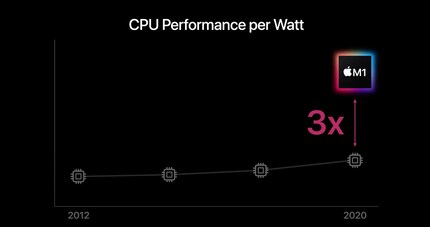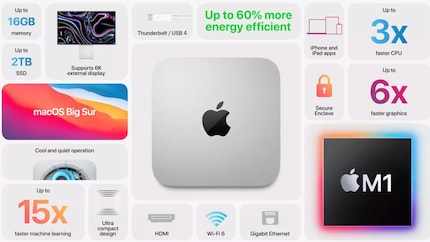
Apple’s «One More Thing» event: hi, I'm a Mac
Apple’s M1 chip is real, Apple Silicon is coming our way and the Cupertino company really sells itself short. Here’s what had actual pull from Apple’s «One More Thing» event, and what Apple should rethink.
Let’s keep this short, like Tim Cook and Co. in the pre-recorded keynote, which was actually not a «keynote», but an «event» – thank you, Apple, for that most important distinction.
Macbooks with Apple Silicon are marching in. That’s also why I’ll refrain from making any jokes here, because regardless of their performance, the new Apple processors are a historic milestone in the chronicles of computing. By the way, «computing» is one of those nice words used at digitec in an inflationary sense that nobody actually uses outside sales circles. Cool. Computing. Historic. Let’s do this.
Stick to what you’re good at (not what’s cool)
Apple is sticking to its classic style of communication. A hodgepodge of mind-numbing pop music and millennial whoops greets us, with a dash of borderline-brain dead clapping and a pseudo-inspirational message to go along with it. «Fly away,» blah, blah, blah. We’re here for the Apple Macbook. You know, the range of devices that frankly overshadow other laptops. Because they’re just that much better. And just in case you were wondering: yes, this text is being written on a Macbook.

Then comes the unheard of «it's 3.5 times faster» that we’ve been hearing for the past x years. The thing was already 2.5 times faster last year. And 5 times faster, the year before that. A concrete number would be quite nice here. A simple «it does 3.8 teraherps with 17 gigaderps» would do.
But at least Tim Cook thinks it’s «great to see how people use the Mac to do such amazing things.» Such as writing this very text. You’re most welcome, Tim. Thanks for the Mac-chines. (Author’s note: fuck my stupid puns.)
But it’s John Ternus, Vice President of Hardware Engineering, who gets to make the big announcement. From the Bat-Bunker, as seen in «The Dark Knight». Or standing in front of the best green screen I have ever seen.


Really, Tim and John? You’re getting on my nerves. You’re writing actual computer history here, and yet you go for the same old wishy-washy nonsense? Apple’s Silicon looks promising, but it’s ten minutes into the keynote and/or event and/or address, and we’re not a step closer to any concrete information.
And the very moment I stand up with the intention of getting a cup of coffee, John Ternus presents the M1 – the Apple Silicon chip that’s supposed to be infinitely better than the competition. I’m more excited to see the Apple Silicon chip’s benchmark results than those of any other processor from the past years.
And then… the M1
«Let's spend a few minutes on a deep dive,» says John Ternus. Wait. Really? Miracles do happen! Thank goodness, because I’m only seven minutes into this keynote-event-thingamabob and it feels like it’s been going on for a decade.
What? I’m not good with patience when it comes to things I think are really cool and that I’m really excited about.
Johnny Srouji, Senior Vice President of Hardware Technologies at Apple, is calling the M1 a system on a chip (SoC). It’s a term that’s widely used in the world of smartphones and, put simply, means that several components are built into one functional unit. For example, it encompasses camera APIs, processor cores, often times RAM and audio interfaces. The clou is that an SoC is much more than a processor; because how it’s built, it’s more than just the sum of its parts. And that’s precisely what already differentiates Apple from the rest. Apple’s hardware and software work nearly seamlessly together, which leads to better performance than the hardware or software alone would allow for.
And now, along comes Apple with an actual SoC. I need that thing.
Until now, all Macs – not just Macbooks – have had to rely on a whole array of chips in order for all the features to work.

All these components will now be unified in one SoC, which is supposed to increase efficiency and performance. The fact that the M1 is supposed to be produced using the 5 nm process also helps. It’s the up and coming standard – 7 nm is currently the most widespread in smartphones. This more tightly tailored manufacturing process makes the chips even faster and more energy-efficient. Johnny Srouji can’t resist making the marketing mumble jumble claim that it’s «measured at an atomic scale». Not quite the deep dive I was expecting, but I’m impressed. Though, strangely enough, less so by the 16 billion transistors in the M1 chip. If Johnny hadn’t prefaced it by «the largest number ever», it probably would have come across as more serious.

And then comes a diagram showing the individual parts of the SoC in detail; a diagram that says nothing, really, aside from, «We’re Apple, and we like to ramble on and on and on...» Because just looking at the depiction of the eight processor cores, key specs, such as gigahertz, are missing.

Then the slide changes to one with actual, concrete numbers. That’s all nice and well, but they make no sense in this context. Would it have killed Apple to provide reliable and sensible numbers instead of the usual baloney? Especially given they’re writing computer history.

It almost hurts to see Apple mess up a developmental milestone so much that it just sounds like the presentation of the nth iPad generation. It really doesn’t do their own product justice.

And then… hold your horses! Axis labels are for people who use Android and Windows and still live in their mother’s basement.

And dimensions are apparently also not a popular concept in Cupertino.

«This is unheard of,» says Johnny Srouji. It’s one of a kind; never been done. Well, I can explain why that’s the case. Because Apple’s gorgeous PowerPoint slides are shit. Nobody with even half a brain cell of knowledge about data representation would present data this way. Axis labels are the minimum; even spacing between the points on the axis of unspecified units would be nice extra. I’m having déjà vu. I vaguely recall my own loose interpretations of things in my second geometry lesson up on the Rohrschacherberg, in the Schulhaus Steig. Grüezi, Mr. Liebing. I know, I put you through a fair bit.
And then, right around the point when the deep dive couldn’t have got any worse and had basically become a parody of itself… useful information:

According to Johnny Srouji, the M1 also promises previously unattained performance in machine learning. Video, text and voice analysis are supposed to be better than ever before. We’re now in the territory of usefulness, since video and voice analysis are Siri’s core capabilities. She’s already quite good, but of course has room for improvement. Or he, since Siri can also be male.

Big Sur is coming in a few days
Craig Federighi, Senior Vice President of Software Engineering, announces to the world: Apple’s new macOS version, named Big Sur, will be here on 12 November 2020. If you have an old Macbook, the update is worth it even just for the new look. Everything looks more streamlined, the menu bars have been simplified and made more coherent, and even Finder threatens to scratch at the surface of usability.

On the old chip architecture, the upgrade is not quite the milestone Craig Federighi makes it out to be. It’s good, don’t get me wrong, but not sensational. But Federighi isn’t talking about the present, which is currently lying next to my now-empty bottle of coke in the form of a Macbook. He’s talking about the future. On M1 architecture, Big Sur is supposed to be sensational.
Craig, I want to take your word for it. Another reason to buy the Macbook as an early adopter.
It’s nice that Craig gets to live out his love for detail. He tells us about animations, responsiveness and all the little things that we as users only notice unconsciously – or not at all. And now that Craig has mentioned it, I do see that the animations when opening apps are really nice. Is it earth-shattering? No. Is it pretty? Yes.
It gets exciting when Craig starts talking about battery life on the M1. Macbooks already have nothing to be ashamed of when it comes to power management. But if Apple improves it further, some other notebooks might really start sweating.
Apropos «other notebooks», the old architecture and Intel Chips aren’t going anywhere. Because regardless of how good the M1 will be, many users will wait before upgrading their gear, since Macbooks aren’t exactly cheap. Worth the money? Yes. Objectively low-priced? No. That’s why Craig is calling Universal Apps into life; applications that are built in binary, but are compatible with both Apple Silicon and Intel processors.
If a developer fails to create an M1 version of his App – for completely unknown reasons, I’ll just casually point my finger at Adobe here – Apple’s Rosetta will come into play. It’s supposed to guarantee compatibility with the new architecture. Certain apps are even supposed to run better via Rosetta than on Intel. Craig, if you’d be so kind as to tell me exactly what these «certain apps» are, I’d be happy to test them. Because this seems like a big thing.

The gap closes
Craig then proceeds to almost casually throw in another point that’s a milestone in computing. With Apple Silicon, iPhone and iPad apps have native compatibility with Macbook and Mac architecture. This means better integration, improved responsiveness, prettier layouts – an overall superior experience.
This is where the standard user’s and coder’s perspectives diverge. Where a coder sees a milestone, a user might see Candy Crush on his Macbook. This is exactly what Apple has been working towards for a long time – a seamless integration experience for the user. Devices are supposed to neatly merge and content is supposed to work on any device.
And now, because each paragraph requires a multimedia element, here’s a video that has nothing to do with the integration, but really piles it on.
What remains are Macs
The significance of this new technology is totally irrelevant from the user’s perspective if there are no machines for it to run on. Apple isn’t stingy and whacks out a portfolio designed to help the M1 break through.

- Apple Macbook Air: 13-inch display, 8-core GPU, 256 or 512 GB storage
- Apple Macbook Pro: 13-inch display, 8-core GPU, 256 or 512 GB storage, Touch Bar
- Mac mini: 8-core GPU, 256 or 512 GB storage
Detailed specs will follow shortly along with the sales start. On 11 November 2020. That might not yet be the sales start, but that’s when we’ll know more.
Update: now available for preorder, plus all the specs
My coworker Sebastian Karlen worked his magic and has registered the Macbooks in our system. So: you can preorder them now.
As the keynote-event-thing comes to an end, Apple proves it does have a sense of humour. And precisely the kind that suits the company quite well. At timestamp 45:30, the guy from the legendary «Hi, I'm a PC» campaign shows up. The very same guy who’s endured many verbal insults being hurled at him by the Apple Mac, played by actor Justin Long.
Here’s a little «memberberry»:
There we go. Done. Can I please have a laptop now?
Journalist. Author. Hacker. A storyteller searching for boundaries, secrets and taboos – putting the world to paper. Not because I can but because I can’t not.